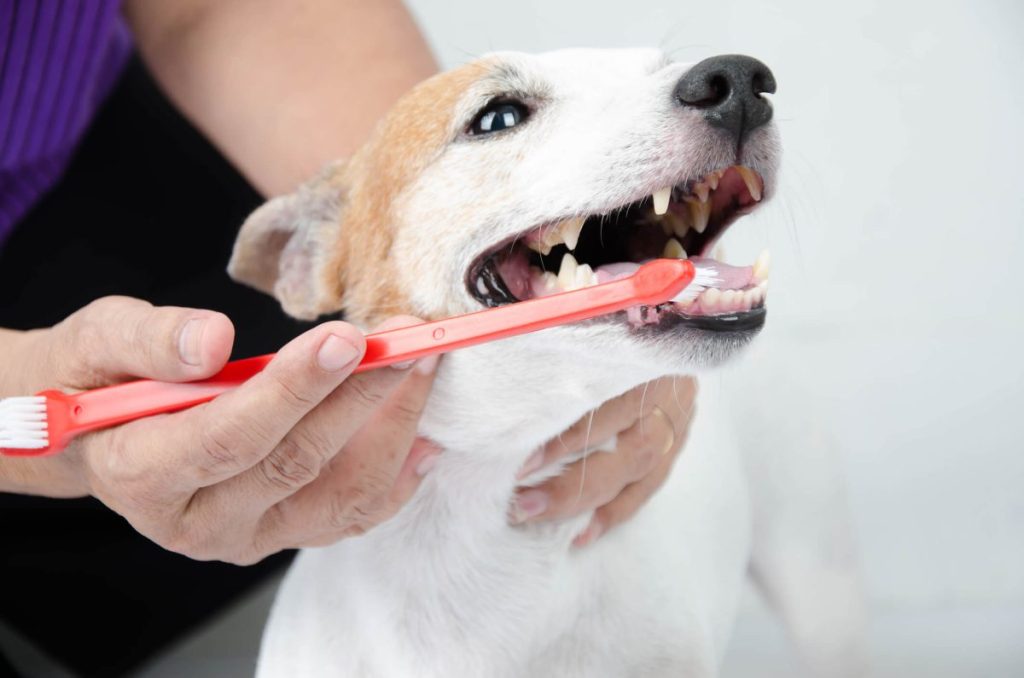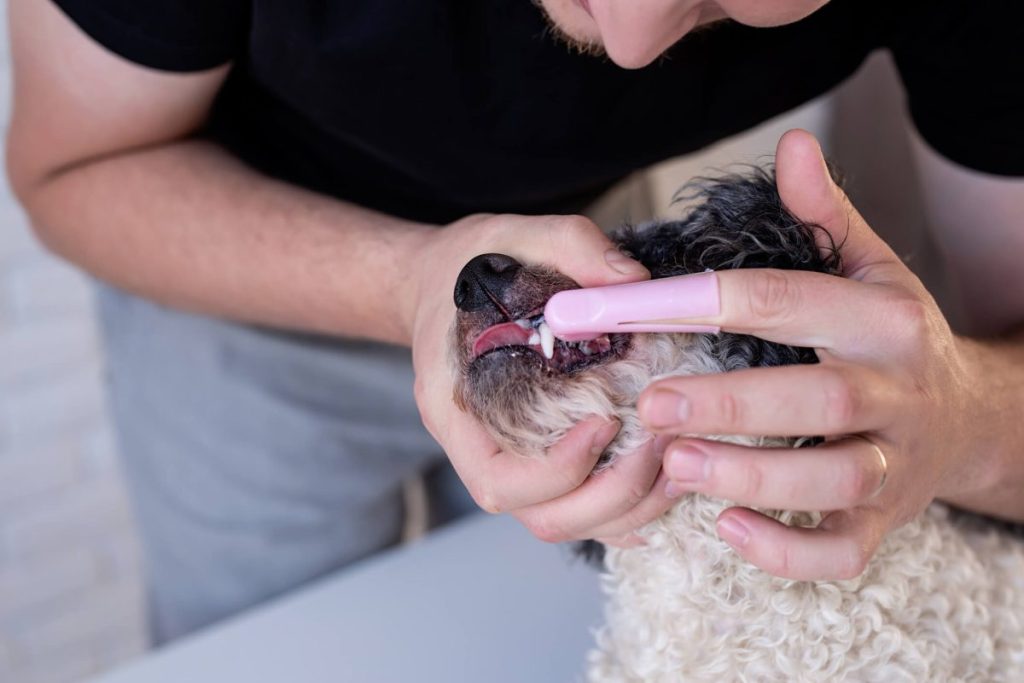While many dog parents focus on nutrition, exercise, and regular vet check-ups, dental care is equally essential. Good oral hygiene not only prevents bad breath but also helps avoid more severe health problems like periodontal disease, infections, and even organ damage. One of the simplest and most effective ways to maintain your pet’s dental health is by using a dog toothbrush. These tools are specifically designed to accommodate the unique shape and size of a dog’s mouth. Let’s understand why a dog toothbrush is necessary, how to choose the right one, and the best practices for incorporating it into your pet’s grooming routine.
Why you shouldn’t use a human toothbrush for your dog
Using a human toothbrush on your dog might seem like a harmless or even practical solution, but it is not recommended. Human toothbrushes are designed for the contours and size of human mouths, which differ significantly from those of canines. The bristles on a human toothbrush can be too firm and abrasive for a dog’s gums, potentially causing irritation or even injury. Additionally, the size and shape of the brush head may make it difficult to reach all areas of your dog’s mouth, especially the back molars where plaque and tartar tend to accumulate.
Dog toothbrushes, on the other hand, are specifically designed with a dog’s oral anatomy in mind. They typically feature softer bristles and a more ergonomic design that makes brushing both effective and comfortable for your pet. Some dog toothbrushes also come with angled heads to better reach those tricky areas and ensure a thorough cleaning. Therefore, by using a toothbrush for dogs, you are more likely to maintain your pet’s dental health without causing undue discomfort or harm.
What are the different types of dog toothbrushes?

Before you begin brushing your pet’s teeth, it’s important to understand the various types of dog toothbrushes available. Each type caters to different needs and preferences, so understanding the differences can help you choose the best one for your furry friend.
Standard dog toothbrushes
Standard dog toothbrushes closely resemble human toothbrushes but are specifically designed for canine oral anatomy. They usually have a longer handle and a smaller, more angled brush head to reach all areas of your dog’s mouth.
Best for: Dogs who are accustomed to regular brushing and pet parents who prefer a familiar brushing method.
Pros:
- Easy to find in stores
- Effective at cleaning hard-to-reach areas
- Often available in dual-head designs for varied brush sizes
Cons:
- May be challenging to use with fidgety or anxious dogs
- Requires some level of cooperation from your dog
Finger toothbrushes
Finger toothbrushes are small brushes that fit over your finger, allowing for more control and a gentler brushing experience. They typically have soft bristles to minimize discomfort.
Best for: Puppies, small dogs, and dogs new to toothbrushing, as well as pet parents who prefer more direct control during brushing.
Pros:
- Easy to use and maneuver
- Provides a gentle brushing experience
- Good for introducing dogs to toothbrushing
Cons:
- Less effective at reaching the back teeth
- Requires close proximity to the dog’s mouth, which may not be ideal for aggressive chewers or nervous dogs
Double-ended toothbrushes
These toothbrushes have two brush heads — one at each end — with different sizes. This design allows for more versatility, making it easier to clean various parts of the mouth effectively.
Best for: Medium to large dogs, or households with multiple dogs of different sizes.
Pros:
- Versatile for dogs of different sizes
- Can reach all areas of the mouth effectively
- Cost-effective as one brush serves multiple purposes
Cons:
- Larger size may be intimidating for small dogs
- May require some practice to use both ends efficiently
Electric toothbrushes
Similar to human electric toothbrushes, these come with a motorized brush head that oscillates or rotates to clean your dog’s teeth more thoroughly. They often come with various speed settings and brush heads.
Best for: Dogs with severe dental issues or those needing more thorough cleaning, and pet parents comfortable with using advanced tools.
Pros:
- Highly effective at removing plaque and tartar
- Multiple settings for customized cleaning
- Can be less labor-intensive for the pet parent
Cons:
- More expensive than manual toothbrushes
- Noise and vibrations may scare some dogs
- Requires regular battery charging or replacements
Silicone toothbrushes
These toothbrushes use soft silicone bristles instead of traditional nylon. As a result, they are more gentle on the gums and teeth.
Best for: Dogs with sensitive gums or those who are prone to dental discomfort.
Pros:
- Gentle on the gums and teeth
- Easy to clean and maintain
- Durable and long-lasting
Cons:
- May not be as effective at removing heavy plaque and tartar
- Limited availability compared to standard brushes
Chewable toothbrushes
These innovative products are designed as chew toys that also clean your dog’s teeth. They often contain bristles or nubs that help to remove plaque as your dog chews.
Best for: Dogs who resist traditional brushing methods, or pet parents looking for a supplemental cleaning option.
Pros:
- Entertains your dog while cleaning their teeth
- Reduces the stress associated with manual brushing
- Helps to clean teeth and massage gums
Cons:
- May not replace the need for traditional brushing entirely
- Effectiveness depends on how thoroughly your dog chews the toy
- Needs regular replacement as the toy wears out
How to choose the right toothbrush for your dog?

Now that you’re familiar with the different types of toothbrushes, let’s explore how to choose the right one for your dog. Selecting the appropriate toothbrush is crucial not only for effective dental care but also for ensuring your pet’s comfort. Here are some tips to consider when making your choice:
Understand your dog’s size and breed
The first step in choosing a toothbrush for your dog is to consider their size and breed. Smaller dogs generally have smaller mouths, so they require toothbrushes with smaller heads and softer bristles to navigate tight spaces effectively. On the contrary, larger breeds can handle toothbrushes with bigger heads. Some breeds are also more prone to dental issues than others, so it’s worth doing a little breed-specific research.
Select the right bristle type
Just as with human toothbrushes, dog toothbrushes come with varying bristle stiffness. Always go for soft bristles to avoid damaging your dog’s gums. Soft bristles are effective in removing plaque without being abrasive. Stiffer bristles may cause gum irritation and discomfort, making the brushing experience unpleasant for your dog.
Evaluate the handle design
The handle design can make a significant difference in your brushing experience. Look for ergonomic handles that provide a comfortable grip, especially if you’ll be brushing your dog’s teeth regularly. Some handles are longer to help you reach the back teeth more easily, while others are shorter for better control.
Check for special features
Some toothbrushes come with added features like rubber massagers for the gums or flavored bristles to make the experience more pleasant for your dog. While not necessary, these features can be beneficial for dogs who are particularly averse to brushing.
Ensure the material is pet-safe
Most importantly, ensure that the toothbrush is made of pet-safe materials. Since dogs tend to chew on things, the toothbrush should be durable yet safe if accidentally ingested. Avoid cheap, low-quality brushes that can break easily or have bristles that can come loose.
Read reviews and do research
Before making a purchase, take the time to read reviews and do some research. Customer feedback can provide valuable insights into the durability and effectiveness of different toothbrushes. Websites and forums dedicated to pet care often have detailed reviews and recommendations. As such, comparing various products can help you make an informed decision.
Consult your veterinarian
If you’re still unsure which toothbrush is best for your dog, consult your veterinarian. They can provide personalized recommendations based on your dog’s size, breed, and specific dental health needs. Your vet may also have samples you can try before making a purchase.
How to use a dog toothbrush?

No matter how perfect the toothbrush is, it won’t do much good if your dog is terrified of it. That’s why it’s important to introduce the toothbrush gradually. Here’s how you can make the toothbrushing process easier:
- Acclimate your dog: Before introducing the toothbrush, get your dog used to having their mouth touched. Gently lift their lips and rub your finger along their gums and teeth. Offer praise and treats to create a positive association.
- Introduce the toothbrush: Let your dog sniff and lick the toothbrush to get familiar with it. You can also dip it in something tasty like broth to make it more appealing.
- Use dog toothpaste: Apply a small amount of dog-specific toothpaste to the toothbrush. Allow your dog to taste the toothpaste first to ensure they like the flavor. Never use human toothpaste, as it can be harmful to dogs.
- Start slowly: Begin by lifting your dog’s lips and gently brushing one or two teeth. Gradually increase the number of teeth you brush each day. Hold the toothbrush at a 45-degree angle to the teeth and use gentle, circular motions. Pay special attention to the molars and canines, which are more prone to plaque buildup. Brushing the front teeth is usually easier, so start there before moving to the back teeth.
- Be patient and consistent: If your dog resists, don’t force them. Instead, take a break and try again later. Remember, consistency is key, so aim to brush your dog’s teeth at least three to four times a week, if not daily. The more consistent you are, the better the results.
- Use positive reinforcement: Reward your dog with praise, treats, or playtime after each brushing session. This will help them associate toothbrushing with positive experiences, making future sessions easier and more pleasant for both of you.
Maintaining your dog’s toothbrush
As important as it is to choose the best toothbrush for your dog, it’s equally important to maintain it properly. First and foremost, after each use, thoroughly rinse the toothbrush with warm water to remove any residual toothpaste, saliva, or food particles. This helps prevent the growth of harmful bacteria and ensures that the brush remains effective for every cleaning session.
If the toothbrush shows signs of wear — such as frayed bristles or a bent handle — it’s time to replace it. Typically, your dog’s toothbrush should be replaced every three to four months, or sooner if it becomes noticeably worn out. It’s also advisable to replace the toothbrush after your dog has been sick. This prevents the potential reintroduction of harmful bacteria or viruses that could cause another bout of illness. Keeping a backup toothbrush on hand ensures you’re always prepared for an immediate switch when needed.
In addition to regular cleaning, consider soaking your dog’s toothbrush in a pet-specific antibacterial rinse once a week to sanitize it thoroughly. These rinses can help eliminate any bacteria that water alone might not remove. Make sure to store the toothbrush in an upright position in a clean, dry place, ideally in a protective case to avoid contamination from other surfaces. Remember, regularly maintaining your dog’s toothbrush not only prolongs its usability but also helps to safeguard your pet’s overall dental health.









